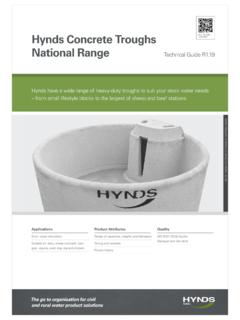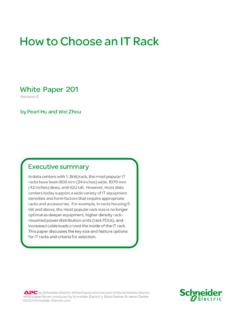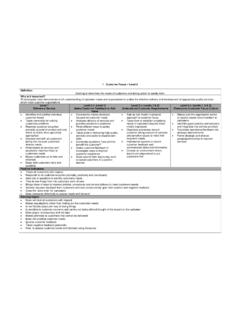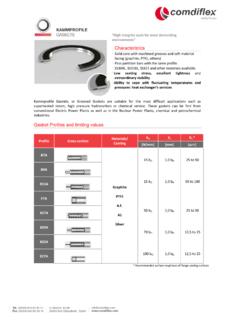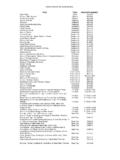Transcription of SIGNIFICANT WEATHER PROGNOSTIC CHARTS
1 11-1 SIGNIFICANT WEATHER PROGNOSTIC CHARTSS ignificant WEATHER PROGNOSTIC CHARTS (progs) (Figure 11-1) portray forecasts of selected weatherconditions at specified valid times. Each valid time is the time at which the forecast conditions areexpected to occur. Forecasts are made from a comprehensive set of observed WEATHER conditions. Theobserved conditions are extended forward in time and become forecasts by considering atmospheric andenvironmental processes. Forecasts are made for various periods of time. A 12-hour prog is a forecast ofconditions which has a valid time 12 hours after the observed data base time, thus a 12-hour forecast.
2 A24-hour prog is a 24-hour forecast, and so on. For example, a 12-hour forecast based on 00 Zobservations is valid at 12Z. Altitude information on the prog CHARTS is referenced to mean sea level(MSL) and compatible with aviation. Altitudes below 18,000 feet are true altitudes while above 18,000feet are pressure altitudes or flight levels (FL). The prog CHARTS for the conterminous United States aregenerated for two general time periods. Day 1 progs are forecasts for the first 24-hour period. Day 2progs are forecasts for the second 24-hour period.
3 Day 1 prog CHARTS are prepared for two altitudereferences in the atmosphere. Forecast information for the surface to 24,000 feet is provided by the low-level SIGNIFICANT WEATHER prog chart . Forecast information from above 24,000 to 60,000 feet is providedby the high-level SIGNIFICANT WEATHER prog chart . The day 2 prog chart is prepared without regard toaltitude and is provided by the 36- and 48-hour surface prog LOW-LEVEL SIGNIFICANT WEATHER (SIG WX) PROGThe low-level SIGNIFICANT WEATHER prog chart (Figure 11-1) is a day 1 forecast of SIGNIFICANT WEATHER forthe conterminous United States.
4 WEATHER information provided pertains to the layer from surface toFL240 (400 mbs.) The information is provided for two forecast periods, 12 hours and 24 hours. Thechart is composed of four panels. The two lower panels depict the 12- and 24-hour surface progs that areproduced at Hydrometeorolgical Prediction Center (HPC) in Camp Springs, Maryland. The two upperpanels depict the 12- and 24-hour SIGNIFICANT WEATHER progs that are produced at the Aviation WeatherCenter (AWC) in Kansas City, Missouri. The chart is issued four times a day; and the observation database times for each issuance are 00Z, 06Z, 12Z, and PROG PANELSThe surface prog panels display forecast positions and characteristics of pressure systems, fronts, Pressure SystemsSurface pressure systems are depicted by pressure centers, troughs, and, on selected panels, and low pressure centers are identified by "Hs" and "Ls" respectively.
5 The central pressure of eachcenter is specified. Pressure troughs are identified by long dashed lines and labeled "TROF." Isobars areshown on selected panels. Isobars are drawn as solid lines and portray pressure patterns. The value ofeach isobar is identified by a two-digit code placed on each isobar. Isobars are drawn with intervals of 8mbs relative to the 1,000 mb isobar. Note that this interval is larger than the 4-mb interval used on thesurface analysis chart . The 8-mb interval provides a less sensitive analysis of pressure patterns than the4-mb interval.
6 Occasionally, nonstandard isobars will be drawn using 4-mb intervals to highlightpatterns with weak pressure gradients. Nonstandard isobars are drawn as dashed lines. Examples ofstandard isobars drawn are the 992; 1,000; and 1,008 mb fronts are depicted on each panel. Formats used are the standard symbols and three-digitcharacterization code used on the surface analysis chart . (See Section 5.)PrecipitationSolid lines enclose precipitation areas. Symbols specify the forms and types of precipitation. (See Table11-1.) A mix of precipitation is indicated by the use of two pertinent symbols separated by a symbols are positioned within or adjacent to the precipitation areas.
7 Precipitation conditionsare described further by the use of shading. Stable precipitation events are classified as continuous orintermittent. Continuous precipitation is a dominant and widespread event and, therefore, precipitation is a periodic and patchy event and unshaded. Shading is also used tocharacterize the coverage of unstable precipitation events. Areas with more than half coverage areshaded, and half or less coverage are unshaded. (See Table 11-2.) A bold dashed line is used to separateprecipitation with contrasting characteristics within an outlined area.
8 For example, a dashed line wouldbe used to separate an area of snow from an area of 11-1 Standard WEATHER Symbols Moderate turbulenceRain shower Severe turbulenceSnow Shower Moderate icingThunderstorm Severe icingFreezing rainRainTropical stormSnowDrizzleHurricane (Typhoon)11-4 Table 11-2 SIGNIFICANT WEATHER Prog SymbolsIntermittent snow Rain showers coveringhalf or less the areaContinuous rainRain showers andthunderstorms covering morethan half the areaSIGNIFICANT WEATHER PANELSThe SIGNIFICANT WEATHER panels display forecast WEATHER flying categories, freezing levels, and turbulencefor the layer surface to FL240.
9 A legend on the chart illustrates symbols and criteria used for theseconditions. (See Figure 11-1.) WEATHER Flying CategoriesThe WEATHER flying categories are visual flight rules (VFR), marginal VFR (MVFR), and instrumentflight rules (IFR). Ceiling and visibility criteria used for each category are the same as used for theweather depiction chart . (See Section 6.) IFR areas are enclosed by solid lines. MVFR areas areenclosed by scalloped lines. All other areas are LevelsThe surface freezing level is depicted by a zigzag line and labeled "SFC.
10 " The surface freezing levelseparates above-freezing from below-freezing temperatures at the Earth's surface. Freezing levels aloftare depicted by thin, short dashed lines. Lines are drawn at 4,000-foot intervals beginning at 4,000 feetand labeled in hundreds of feet. For example, "80" identifies the 8,000-foot contour. Freezing levelheights are referenced to MSL. The lines are discontinued where they intersect corresponding altitudesof the Rocky Mountains. The freezing level values for locations between lines is determined by linearinterpolation.
